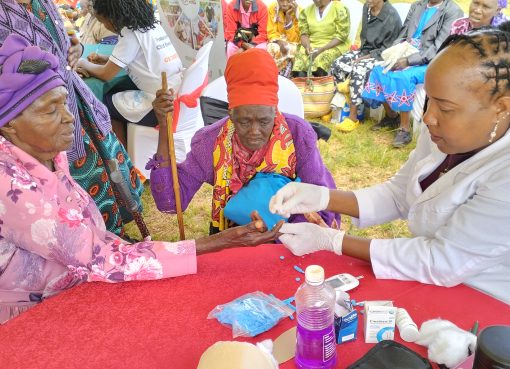As the weather in the country continues to deteriorate because of climate change, there is a need for livestock farmers to engage in climate smart approaches, especially for their livestock.
According to the International Livestock Research Institute (ILRI), using extensive pastoral grazing systems to support livestock dependent communities is key.
ILRI has in their Kapiti Research Station situated on Mombasa road in Machakos County helped increase incomes for Kenya’s small-scale milk producers, processors and sellers in improving on their feeds, especially through training and holding farmers’ field days.
Speaking during a media tour and a livestock farmers field day, Ilona Gluecks, Head of Clinical Research facilities at ILRI, says that together with partners they have been working towards improving the set-up of feeds for livestock farmers to be able to produce more milk with not only the breeds that they have been having, but also on improved ones.
“We have also been training farmers to produce different fodder varieties and showing them how to grow, manage, harvest them and feed their animals,” she said.
Gluecks added that there is an urgent need today to support smallholder livestock producers, given their critical role that they play in providing solutions to the food, nutrition and economic challenges that are intensifying across the continent.
“If you do not feed your livestock nicely and well, it will not produce and thus it’s important for one to improve genetics and this can improve a lot of things,” she said, adding that the “Feed and Fodder Day” at Kapiti will see the over 250 farmers participating learn about innovative approaches to providing sustainable, nutritious feed for their cattle, sheep and goats
Gluecks added that it is part of the Kenya Nourishing Prosperity Alliance (KNPA), a Public-Private Partnership to strengthen dairy production in Kenya through improved livestock nutrition.
Ian Mutua, Lead Agronomist KNPA, said they have been engaging small scale dairy farmers, especially women since they have the potential not only to make an income to themselves but also to uplift the household as a whole system.
“Targeting these farmers we believe they are the right people who can implement what we are training here. We want to create awareness that we have different types of foliage that can do well in this ecological zone and through women empowerment the youths can adopt these technologies”, he explained.
Mutua noted that that they are training farmers on silage Maize, nutrient dense foliage namely Lucerne, Pearl Millet, foliage Sorghum among others which are well improved but also ensuring that the farmers plant on the foliage that is good for their ecological areas.
“First we are doing soil analysis, checking on pH, nutrient available then matching that with a particular foliage for a particular region because the reason we have under production/inadequate feed is that farmers are not considering the soil health when it comes to feeding,” he said.
Mutua further said that a farmer might have the correct soils but lack the know-how on maximizing a particular foliage variety, proper spacing, different cutting stage and also management and that is why training on management at the field-day is important in order for them to get quality foliage.
Helen Nzioki, a dairy farmer who attended the farmers field day said she has been practicing dairy farming since 1998 and although there have been good times, because of dry spell she is forced to ration feed for her animals or dig deeper into her pockets to secure more fodder.
“Currently, my 12 cows produce 30 litres of milk in a day and I wish this training had come even earlier than now for me. I have benefited a lot as I have learnt how to produce maize silage and the best maize varieties to use for this purpose. I shall go and practice silage making so that I can be making feed for my dairy animals available during the dry season and am sure this will also increase my milk production,” Nzioki said.
Joseph Mbindyo, a father of three and who has been a dairy farmer for the last seven years acknowledged that for him, dairy has not been a walk in the past as he has been struggling with challenges, especially of feed due to the poor rains.
“Climate change is real, rainfall in Masii where I come from is a challenge. I have been relying on rain fed fodder that I was cutting and storing but as time went by it became less and less due to low rainfall and now no rain at all,” he says.
Due to the prolonged dry season, Mbindyo said he has been forced to reduce his herd by selling part of them in order to feed a few, taking them for long distances in search of water and pasture, which is also a problem and this has seen his cows also experience diseases.
“I have learnt from this field day about supplements that dairy farmers like me can use, I have learnt on how to manage my fodder, the varieties of grass and how to ensure my silage is healthy for my cows. This knowledge and information I have received is what I will practice once I leave this place,” he said
During the training of the farmers there were discussions of genetic traits in African livestock developed through centuries of indigenous breeding that will be critical for sustainably increasing livestock productivity in the face of increasing climate stress.
ILRI’s 32,000-acre Kapiti Research Station, is a laboratory for studying and improving livestock production in Africa’s tropical drylands. It has helped increase incomes for Kenya’s small-scale milk producers that now generates Sh3.3 billion in related benefits to the country.
The livestock sector today contributes more than 40 percent to Kenya’s agricultural gross domestic product, at a total value of Sh 515 billion, and employs 50 percent of the country’s agricultural labour force.
By Wangari Ndirangu





